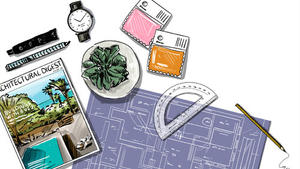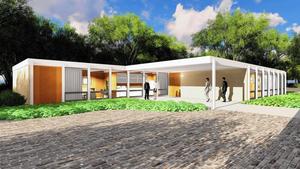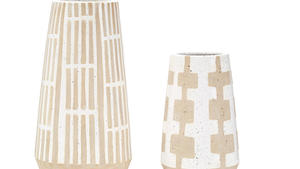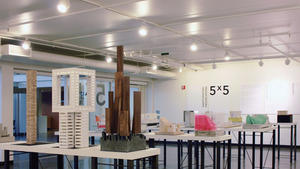Plenty of designers share memories of their childhood homes, their formative influence on their design sense, whether reworking a deck in Barbie’s Malibu Beach House or shuffling furniture around the family room. But the childhood summer abode of designer Bonnie Steves, of the New York firm BJS Assoc., is both inspirational and aspirational. It’s also a far cry from the big city she now calls home.
Her family’s southwest Colorado property, Cresto Ranch at Dunton Hot Springs, located on the West Fork of the Dolores River, has shaped her design sense as well as the history of her family—and it’s a story that began when two immigrants from Italy began making their own American dream.
Dunton River Camp at Dunton Hot Springs today
Dunton Hot Springs is today a five-star resort, outfitted with cabins, a natural hot springs and spa. But the area’s history is straight out of a Wild West tale. For one, Wild West legend Butch Cassidy, it’s said, carved his name in a Dunton saloon after his first bank robbery. Steves’s great-grandfather, Joseph Roscio, an Italian immigrant by way of Minnesota, was a pioneer in his own right, settling in the area in the 1880s. Roscio, who had changed his name from Rosario upon arrival in America (he and his wife Dominica arrived through Ellis Island), originally settled his family of nine (which included Steves’s grandmother, Adele) in Telluride to work in the area’s punishing gold and silver mines.
“With the expansion of mining throughout the Colorado basin, immigrants were encouraged to move to the state,” Steves explains. “The exhausting and dangerous work of extracting coal, gold and silver from open-pit mines was often the only employment available to immigrants with limited education and limited access to working capital. Also, many immigrants from Italy, Germany and Russia were hired to replace striking workers through the numerous violent clashes that erupted during Colorado’s labor wars during the first decade of the 20th century.”
The family later moved to the area known as Dunton in 1918, purchasing a 260-acre plot of land and making a living by trapping and logging. They then began building and renting out cabins and ran a lodge and a bar. The price to use the nearby untapped sulfur hot springs? A nickel. Says Steves, “The first hot tub was formed by digging a pit approximately 14 by 20 feet, lining it with logs, and diverting the hot water source into the pit. The mineral content of the water was so high it shortly formed a smooth, copper-colored, mineralized coating evenly over the edge. They also ran a cattle ranch on the land, eventually purchasing the 500 acres surrounding the property.” (Three of the family’s brothers transformed what became known as Dunton Hot Springs into a dude ranch designed for tourists, which ran from the 1930s through early 1970s.)
Meanwhile, Steves’s grandfather Terzo A. Cresto (her grandmother Adele Roscio’s future husband) arrived in Colorado from Turin in 1905 with his widowed mother in search of a better life. Cresto attended school until 8th grade but was forced to work after his mother died. He took on jobs mining and feeding and caring for cattle, and later started a livestock operation near Dunton, where he’d meet the Roscio family, and fall in love with Adele. The couple purchased land 5 miles from Adele’s childhood home in Dunton, eventually purchasing an additional 400 acres around their ranch and running a 75-mile cattle drive twice a year in a place that came to be known as Cresto Ranch. A freshwater spring and aspen, spruce and alpine fir abounded on the property; the five-bedroom ranch house also included a workshop, barn, granary and garage.
The couple had two daughters, including Steves’s mother. As she recalls, “They were a self-made couple that was small in stature but as big as the mountains they loved in their hearts. They left a legacy of love, generosity and inspiration not only to their family but to all of those associated with them.”
That Roscio-owned Dunton property, those few miles away, was sold in 1974 to a group of investors, but was largely undeveloped for some time. Says Steves, “For more than 20 years, the little-known settlement in the woods became a hangout where locals, bikers and hippies partied in the hot pools, gazed at the stars in an inky sky and imbibed spirits as they dreamed of the Old West. The decrepit cabins, with weather pouring in through un-chinked logs, were rented out for $5 to $25 a night.”
Steves, along with her four siblings, spent nearly all of their childhood summers in the (non-winterized) Cresto Ranch, working alongside their grandparents: Mornings started with firing up the wood-burning stove, milking cows and making a breakfast, sometimes of fresh-caught rainbow trout and biscuits. Days were filled with tasks—chopping wood, feeding the horses, curing cottage cheese—and activities like baking sourdough bread and cinnamon buns, decoupage and crocheting, and heavy-duty work.
At the end of the day, recalls Steves, “We would go fishing, but first we would have to dig for worms along the stinging nettles. If there were no worms, then we would take a hike to the mines or our mini-camps. A big day would be when we would take a ride with grandma up the river to Dunton to visit our great-uncles and aunts as well as all the guests staying in the cabins. A lot of the time, we would also do some canning of pickles, tomatoes, peaches and a slew of other vegetables. Very often, we would also head into the woods to go mushroom hunting or pick wild raspberries and rhubarb.”
“No doubt, all of these experiences have greatly influenced my life in every way, leaving an indelible impression on everything that I do,” says the designer. “Our summers were filled with the good life: beauty, aspiration, appreciation, hard work, fun, laughter, family and love! Today, those philosophies continue to influence both my life and designs, and I am committed to bringing that to all of my projects.” Nature, both its beauty and its inherent challenges, has also played its role in forming her aesthetic. “Because we lived off the land, I have a great deal of respect and passion for the environment,” she says.
“I was given a lot of tools, know-how, artistry, ingenuity and sophistication.”




























